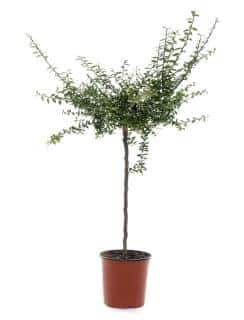

Finger lime is a thorny citrus variety that is beautiful in pots.
Container Finger lime facts
Name – Microcitrus australasica
Stock type – grafted (usually)
Hardiness – 25°F (-4°C)
Exposure – full sun
Soil – well-drained
Foliage – evergreen
Height – 1 to 4 feet (30 to 120 cm)
Flowering: spring→early summer – Harvest: late fall→spring
Native to Australia, this surprising citrus produces delicious fruits – even indoors!
Usually, you don’t need to repot your Microcitrus australasica immediately; you can wait for following spring.
In a pot, for the first time, one of the most important factors is drainage. Make sure there’s a hole at the bottom of the pot.
Place the pot on a saucer, but put a bed of gravel or pebbles between pot and saucer, so that the bottom of the pot doesn’t sit in excess water.
When in a pot, Australian finger lime cannot extract the nutrients its needs from the ground.
So the pot and soil you have put in it are the only source of food for it to stock up and grow.
Re-potting is thus critical.
In pots, Australian finger lime trees dry up much faster than if they were planted in the ground, so it is essential that they be watered regularly.
The plant has trouble coping with air that is too dry: it develops brown leaf edges. In this case, try to increase humidity in the air around it.
In summer, frequent watering is required, whereas watering can be reduced in winter.
Every two weeks, during the growth phase, add citrus-specific fertilizer to boost fruit-bearing.

Ideally, prune your microcitrus after the harvest, when fruits are ripe and you can pick them.
Try to shape your sapling into a bowl shape, with 3-4 branches that you form. Snip the leader stem to promote their growth. Chose its height so your pot looks most appealing to you.
In time, these will grow thicker as more and more branches sprout from these scaffold branches.
Growing Australian finger lime trees in pots is most adapted. This makes it possible to bring the citrus trees to a well-lit spot where it doesn’t freeze in the winter.
Australian finger lime trees aren’t indoor plants, and can’t bear staying in a heated environment all year round. They need relatively lower temperatures from October to May.
It is important to place them in an unheated greenhouse for instance, where the temperature never drops below 32°F (0°C).
I have inherited a dying lime tree in a pot from my son.
He seems to have cut it right back to the stock onto which it has been grafted.
It is now thriving but still quite small. It is very prickly and its small leaves look more like tiny passionfruit leaves, not at all like, for example, a lemon tree. I’d love it to be a finger lime but he assures me that it is a lime. Do you think it might have reverted to the stock? Its leaves are small and in grioups of three.
Hello Bob, I hate to break it to you, but it’s likely neither lime nor finger lime… but you are close! Most grafted citrus plants use a rootstock called Citrus trifoliata. It’s a species native to China, it has strong thorns and leaves grow in groups of three, indeed similar to those of passion fruit or Mexican orange.
Citrus trifoliata is often chosen because of its resistance to freezing, and it also resists citrus foot rot. It is compatible with nearly all types of citrus. If you let it grow, you’ll get fruit but they’re going to be small, tart and sour, honestly not at all worth the effort in keeping the plant alive. It would probably take on a new graft scion very well, if you can get source material nearby.
If I were you, though, I’d stop trying to care for this particular one, and instead start from a new tree. Better still: get one each and then compete with your son to see who can grow the nicest one! Finger lime is a good idea because of its yummy fruits that, once tasted, are always remembered for that tangy pop.